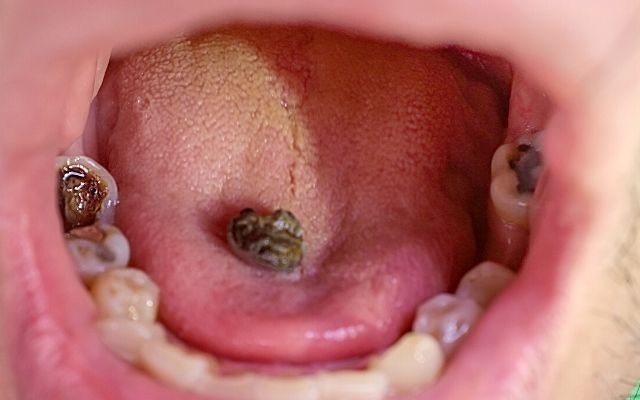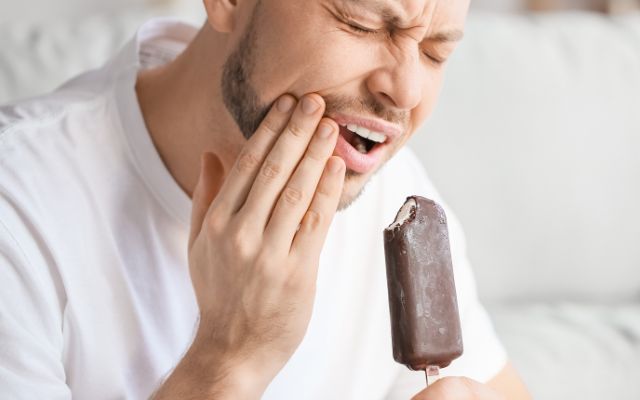Crown/Filling Fell Out: What To Do? – Lost Filling Guide
Crown/Filling falls out or lost? You have no reasons to be nervous when you read this article that shows the causes, solutions as well as steps to prevent dental filling fell out.

Overview of Filling Fell Out Of Tooth
Fillings are a standard method for treating cavities, which are areas of dental decay that develop into small holes. During a filling, your dentist fills these holes with an amalgam or composite material. This is a basic, regular surgery, yet it leaves many patients with sensitive teeth.
Depending on the underlying cause, tooth sensitivity typically resolves on its own within a few days or weeks.
Sometimes a lost filling is more noticeable than others; in some instances, you may feel the filling or detect the void in your tooth. In certain instances, you might not even realize that it has fallen out.
Additionally, be on the lookout for inexplicable dental pain and new sensitivity to warmth and cold, as these could indicate that a filling is becoming worn or loose: dental office, few days, replacement filling, tooth fillings, dental restorations, salt water, dental cement
Some Causes of crown Falls Out
Several factors can result in tooth sensitivity following a filling.
Pulpitis
Before filling a cavity, the decayed portion of your tooth is removed using a drill that generates heat. In rare instances, this causes pulpitis by inflaming the pulp, the connective tissue that forms the center of your teeth. If your dentist does not remove all of the decaying tissue, the pulp of the damaged tooth may become infected. When this occurs, you may observe swollen gums or a pus-filled pocket near the tooth.
Change in Bite
Occasionally, a filling might cause a tooth to be taller than the other teeth. Due to the added pressure on the damaged tooth, this might make it painful to close your mouth. In extreme situations, biting down can even shatter the filling, so if you notice an issue with your bite, call your dentist immediately.
Several Tooth Surfaces
You may also experience discomfort or sensitivity as a result of having two distinct surfaces in your mouth. For instance, if one tooth has a gold crown and the tooth above or below it has a silver filling, you may have a strange sensation when they come into contact.
Referred Agony
Also prevalent is discomfort in the teeth surrounding the afflicted tooth. This is the result of a phenomena known as referred pain, which includes experiencing pain in a location other than the source.
How will I feel after a Lost filling?

Before placing a filling, dentists commonly numb the damaged tooth’s surrounding area. Consequently, you will likely feel nothing for the first hour or two after your session. Once the numbness has worn off, you may experience some odd sensations in your mouth.
Included are:
- Sensitivity in the teeth, particularly while breathing in cold air, drinking hot or Cold drinks, and eating hot or cold food.
- You have gum sensitivity
- When teeth are clenched, there is discomfort surrounding the filling.
- When chewing, brushing, or flossing, the afflicted tooth causes discomfort.
Ways to Treat Filling Fell Out Of Tooth

If your filling becomes loose or falls out, you should have it replaced immediately. Here’s how to proceed.
Methods to take
- Call your dentist as soon as possible to schedule an appointment. Notify the dentist if you are experiencing pain. If you cannot be seen immediately, inquire about ways to preserve your exposed tooth from injury.
- Keep the filling or crown in a cool, safe place so the dentist can decide if it may be reused. If you have lost a crown, the dentist may be able to reattach it.
- To keep the area clean and remove food debris from the tooth, gargle with salt water. Combine a half-teaspoon of salt with one cup of warm water. For a few seconds, gargle. This can help eliminate microorganisms that could cause tooth decay.
- Utilize a dental hygiene regimen to take care of the teeth. Brush the region where the filling came out very softly.
- Avoid chewing on the exposed tooth region.
- Protect the exposed tooth with dental wax or temporary filling material, which is available online. This is simply a temporary remedy until your dentist can fix the filling.
How Long Does Getting A Filling Take?

Typically, a filling takes less than an hour. A basic filling could take as little as twenty minutes. Numerous dental offices now have the technology to create onlays and inlays in a single session, while bigger or multiple fillings may take longer.
Additionally, depending on the materials utilized for the filling, the procedure could take longer or necessitate a second visit. For example:
- Composite resin material that is layered into your tooth requires additional time, but can be done in a single appointment.
- From an impression, some composite fillings can be fabricated. This requires a second visit for the filling to be bonded.
- If your dentist practice has the necessary equipment, gold or porcelain fillings, also known as inlays and onlays, can be placed in a single visit. Otherwise, numerous visits are required.
- The dentist will remove the cavity and take an imprint of your tooth at the initial session. The impression will be sent to a facility where the filling will be created. At the subsequent appointment, the filling will be bonded to the tooth.
Generally, it takes roughly the same amount of time to replace an older filling as it did to place the original filling. If the old filling material must be drilled out, the process may take a bit longer. A healthcare practitioner will remove the cavity’s old filling and then replace it with a fresh one.
Fillings Typically Endure
The durability of a filling is contingent upon the materials employed and the individual’s dental hygiene.
If you diligently maintain healthy teeth and gums and visit your dentist regularly for exams, your fillings will likely last longer.
Rothschild stated that a filling’s durability is also determined by its size and position.
Filling materials, like other structural materials, have strength constraints. This is especially true if fillings are large and are expected to bear a high functional (chewing) stress load or if they are used to lengthen teeth vertically.”
Here are some typical durations for various filler materials:
- Amalgam fillings: five to twenty-five years
- Composite fillings: five to fifteen years
- Gold restorations: 15 to 30 years
Lost Filling Prevention

The key to keeping a filling from coming loose is practicing proper oral hygiene and undergoing routine dental examinations.
Oral hygiene recommendations
- At least twice every day, use fluoride toothpaste to brush your teeth.
- Floss your teeth daily.
- Change your toothbrush every three to four months.
- To eliminate microorganisms and improve your breath, brush your tongue.
- See your dentist on a regular basis for cleanings and examinations.
- Checkups at least once every six months can help detect any problems with a filling before it falls out or creates other complications. Your dentist will be able to determine if a filling is worn and needs to be replaced before it falls out.
Addintional precautionary steps
Do not grind your teeth. There are solutions if this is a problem, especially if you grind your teeth while sleeping. Among the available choices are mouth guards and splints.
- Avoid chewing on tough substances such as ice.
- Be cautious when consuming hard foods such as nutshells, hard candies, and toasted bagels.
- Avoid clenching your teeth.
- Be cautious with sweet and sticky meals. These substances can adhere to teeth, dislodge fillings, and raise the risk of tooth decay.
- Consult a dentist if the region around the filling becomes sensitive to heat or cold or if it begins to hurt.
Urgent Care Dentist Near Me
Despite the fact that proper preventative treatment may aid in preventing certain tooth diseases, dental emergencies may occur on occasion. In dental emergencies, time is of the essence in order to prevent damage.
Certain emergency departments and urgent care dental clinics assist patients with urgent needs 24 hours a day, seven days a week.Spring Orchid Dental Emergency Clinic in Bassendean has emergency dentists that can assist with dental emergencies and other oral health problems.
FAQs about Crown/Filling Fell Out
What do I do if my temporary crown comes off?
If a crown has dropped out of the mouth, make a dental appointment as soon as possible. Keep the crown in a cool, safe place because there is a possibility that the dentist can reinsert it. If the crown is out of the mouth for a long period of time, the teeth may shift or sustain further damage.
When the dentist is not immediately accessible, here are the steps to take:
- Apply clove oil to the tooth to alleviate pain.
- Clean the crown and affix it onto the tooth with dental cement. This can be purchased at the local pharmacy.
- If the crown is lost, smear the top of the tooth with dental cement to alleviate discomfort.
- DO NOT use any kind of glue to affix the crown.
- Get to the dentist, quickly and safely.
The dentist will check the crown to see if it still fits. If it does, it will be reattached to the tooth. Where decay is noted, this will be treated and a new crown will be made.
How long does it take for a filling to stop hurting?
After your filling is completed, it may take some time for any lingering discomfort to dissipate. You may have a dull ache at the site of your dental work for several hours following your appointment.
Also, it can take between 2 and 7 hours for anesthetic to entirely wear off. While the anesthesia wears off, you may experience a pins-and-needles sensation as your nerves recover full function.
If you are in great discomfort, you can take an over-the-counter pain medicine (such as ibuprofen) to alleviate the pain. Additionally, you can apply mild heat or an ice pack to the outside of your jaw to reduce swelling and alleviate pain.
Can a filling that is loose cause complications?
If a filling is not replaced within a few days, the unprotected tooth could sustain harm.
Bacteria and food particles can adhere to the void, resulting in deterioration. In addition, the lost filling may expose the dentin, the second layer of the tooth beneath the outer enamel. Dentin is softer and more prone to degradation than enamel. Dentin that is exposed might also be particularly sensitive.
Additional tooth decay or damage may necessitate more comprehensive treatment, such as a crown, root canal, or extraction. Therefore, the sooner the filling can be replaced, the better.
Conclusion
Dental fillings are a frequent method of treating cavities, which are areas of decaying teeth that create small holes. During a filling, a material, such as amalgam or composite, is used to fill these holes. Despite the fact that this is a simple, normal operation, it leaves many people with sensitive teeth.





